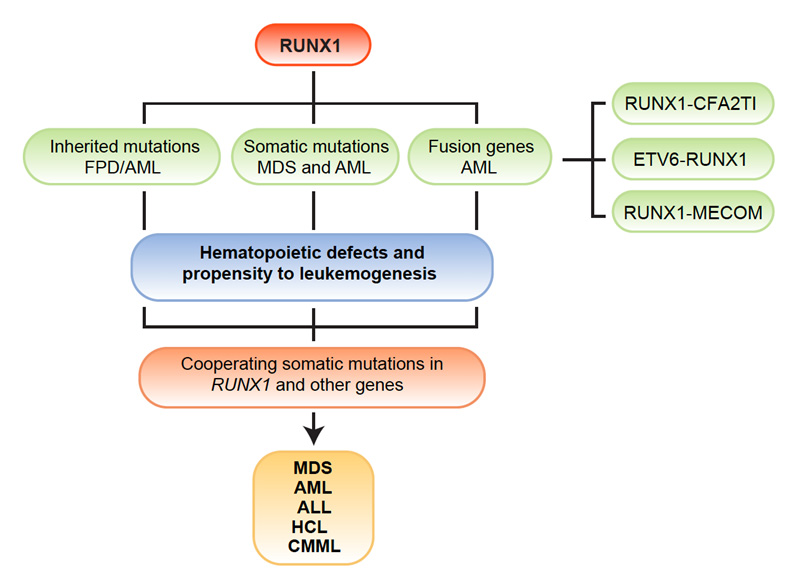Liu P, Tarlé SA, Hajra A, Claxton DF, Marlton P, Freedman M, Siciliano MJ, and Collins FS. Fusion between transcription factor CBFb/PEBP2b and a myosin heavy chain in acute myelomonocytic leukemia. Science, 261:1041-1044. 1993. [PubMed]
Castilla LH, Wijmenga C, Wang Q, Stacy T, Speck NA, Eckhaus M, Marin-Padilla M, Collins FS, Wynshaw-Boris A, and Liu PP. Failure of embryonic hematopoiesis and lethal hemorrhages in mouse embryos heterozygous for a knocked-in leukemia gene CBFB-MYH11. Cell, 87:687-696. 1996. [PubMed]
Castilla LH, Garrett L, Adya N, Orlic D, Dutra A, Anderson S, Owens J, Eckhaus M, Bodine D, and Liu PP. Chromosome 16 inversion-generated fusion gene Cbfb-MYH11 blocks myeloid differentiation and predisposes mice to acute myelomonocytic leukemia. Nat Genet, 23:144-146. 1999. [PubMed]
Blake T, Adya N, Oates A, Zon L, Chitnis A, WeinsteinBM, and Liu PP. Zebrafish homolog of the leukemia gene CBFB: its expression during embryogenesis and its relationship to scl and gata-1 in hematopoiesis. Blood, 96:4178-4184. 2000. [PubMed]
Kundu M, Javed A, Jeon J-P, Horner A, Shum L, Eckhaus M, Muenke M, Lian J, Yang Y, Nuckolls GH, Stein G, and Liu PP. Cbfbeta interacts with Runx2 and has a critical role in bone development. Nature Genetics, 32: 639-644, 2002. [PubMed]
Castilla LH, Perrat P, Martinez NJ, Landrette S, Keys R, Oikemus S, Flanegan J, Garrett L, Dutra A, Pihan GA, Wolff L, Liu PP. Identification of genes that synergize with Cbfb-MYH11 in the pathogenesis of acute myeloid leukemia. Proc Natl Acad Sci USA, 101:4924-4929. 2004. [PubMed]
Zhao L, Cannons JL, Anderson S, Kirby M, Xu L, Castilla LH, Schwartzberg PL, Bosselut R, Liu PP. CBFB-MYH11 hinders early T-cell development and induces massive cell death in the thymus. Blood 109:3432-40, 2007. [PubMed]
Belele C, English MA, Chahal J, Burnetti A, Finckbeiner SM, Gibney G, Kirby M, Sood R, and Liu PP. Differential requirement for gata1 DNA binding and transactivation between primitive and definitive stages of hematopoiesis in zebrafish. Blood, 114: 5162-72. 2009. [PubMed]
Hyde RK, Kamikubo Y, Anderson S, Kirby M, Alemu L, Zhao L, and Liu PP. Cbfb/Runx1-repression independent blockage of differentiation and accumulation of Csf2rb expressing cells by Cbfb-MYH11. Blood, 115: 1433-43. 2010. [PubMed]
Sood R, English MA, Belele C, Jin B, Bishop K, Haskins R, McKinney MC, Chahal J, Weinstein BM, Wen Z, and Liu PP. Development of multi-lineage adult hematopoiesis in the zebrafish with a runx1 truncation mutation. Blood, 115:2806-9. 2010. [PubMed]
Kamikubo Y, Zhao L, Wunderlich M, Corpora T, Hyde RK, Paul T, Kundu M, Garrett-Beal L, Compton S, Huang G, Wolff L, Ito Y, Bushweller J, Mulloy JC, and Liu PP. Accelerated leukemogenesis by truncated CBFb-SMMHC defective in high-affinity binding with RUNX1. Cancer Cell, 17:455-468. 2010. [PubMed]
Zhao L, Melenhorst JJ, Alemu L, Kirby M, Anderson S, Hoogstraten-Miller S, Kamikubo Y, Gilliland DG, Liu PP. C-KIT with D816Y/V mutations cooperate with CBFB-MYH11 to accelerate leukemogenesis in mice. Blood, 119:1511-21. 2012. [PubMed]
Cheng L, Hansen NF, Zhao L, Du Y, Zou C, Donovan F, Chou B-K, Zhou G, Li S, Ye Z, Chandrasekharappa S, Yang H, Mullikin JC, Liu PP. Low incidence of DNA sequence variation in human induced pluripotent stem cells generated by non-integrating plasmid expression. Cell Stem Cell, 10:337-44. 2012. [PubMed]
Cunningham L, Finckbeiner S, Hyde RK, Southall N, Marugan J, Yedavalli V, Dehdashti S, Reinhold W, Alemu L, Zhao L, Yeh JJ, Sood R, Pommier Y, Austin C, Jeang KT, Zheng W, Liu P. Identification of Ro5-3335 as an inhibitor of CBF leukemia through quantitative high-throughput screen against RUNX1-CBFß interaction. Proc Natl Acad Sci USA, 109:14592-7. 2012. [PubMed]
Kamikubo Y, Hyde RK, Zhao L, Alemu L, Rivas C, Garrett LJ, Liu PP. The C-terminus of CBFß-SMMHC is required to induce embryonic hematopoietic defects and leukemogenesis. Blood, 121:638-42. 2013. [PubMed]
Bresciani E, Carrington B, Wincovitch S, Jones MP, Gore AV, Weinstein BM, Sood R, Liu PP. CBFb and RUNX1 are required at two different steps during the development of hematopoietic stem cells in zebrafish. Blood, 124(1):70-8. 2014. [PubMed]
Sood, R., Hansen, N., Donovan, F., Carrington, B., Bucci, D., Maskeri, B., ... Liu, P. Somatic mutational landscape of AML with inv(16) or t(8;21) identifies patterns of clonal evolution in relapse leukemia. Leukemia, doi: 10.1038/leu.2015.141. 2015. [PubMed]
Deuitch N, Broadbridge E, Cunningham L, et al. RUNX1 Familial Platelet Disorder with Associated Myeloid Malignancies. 2021 Mar 4. In: Adam MP, Ardinger HH, Pagon RA, et al., editors. GeneReviews® [Internet]. Seattle (WA): University of Washington, Seattle; 1993-2021. [GeneReviews / NCBI Bookshelf]






